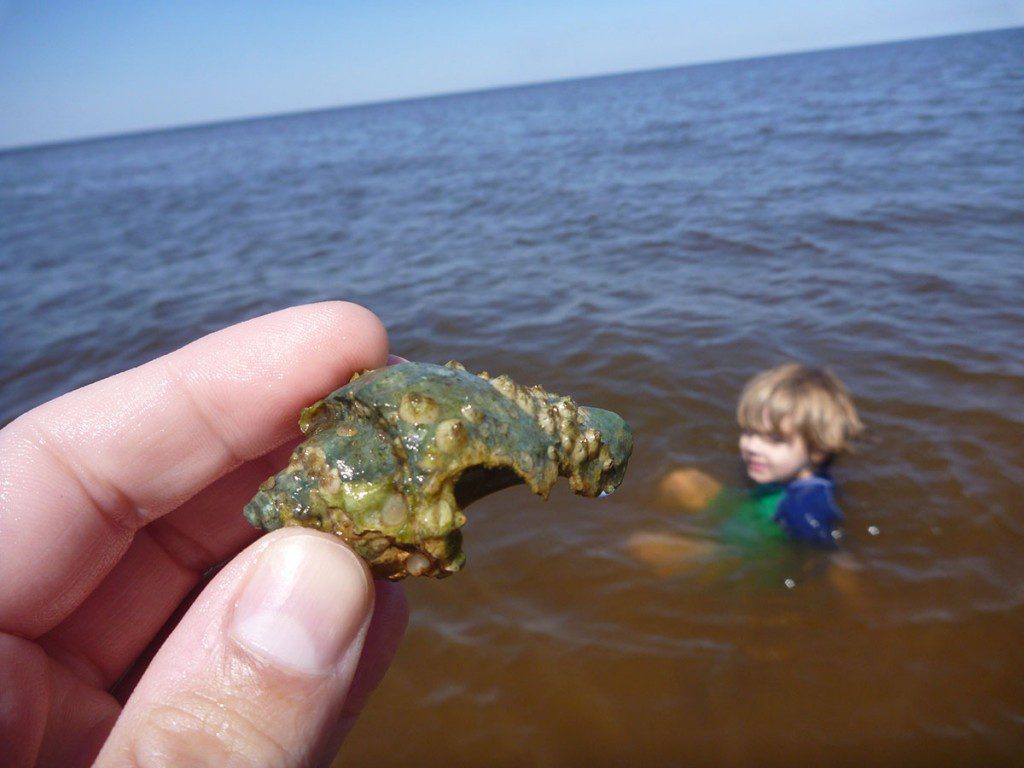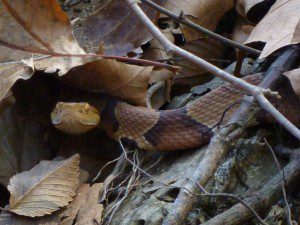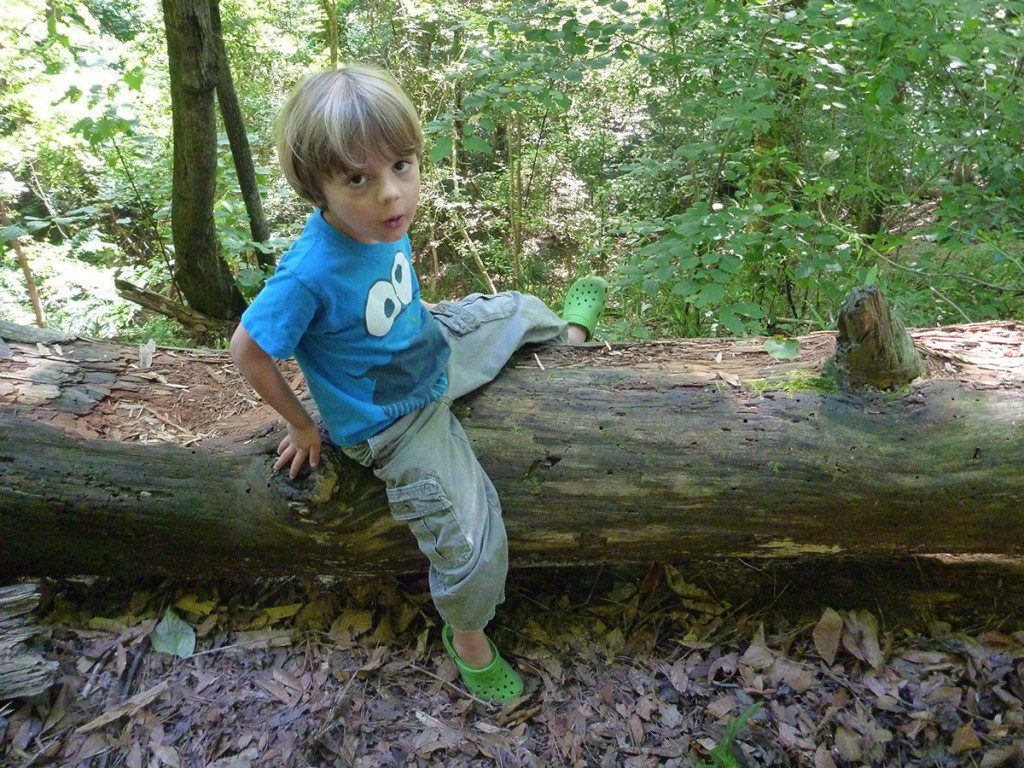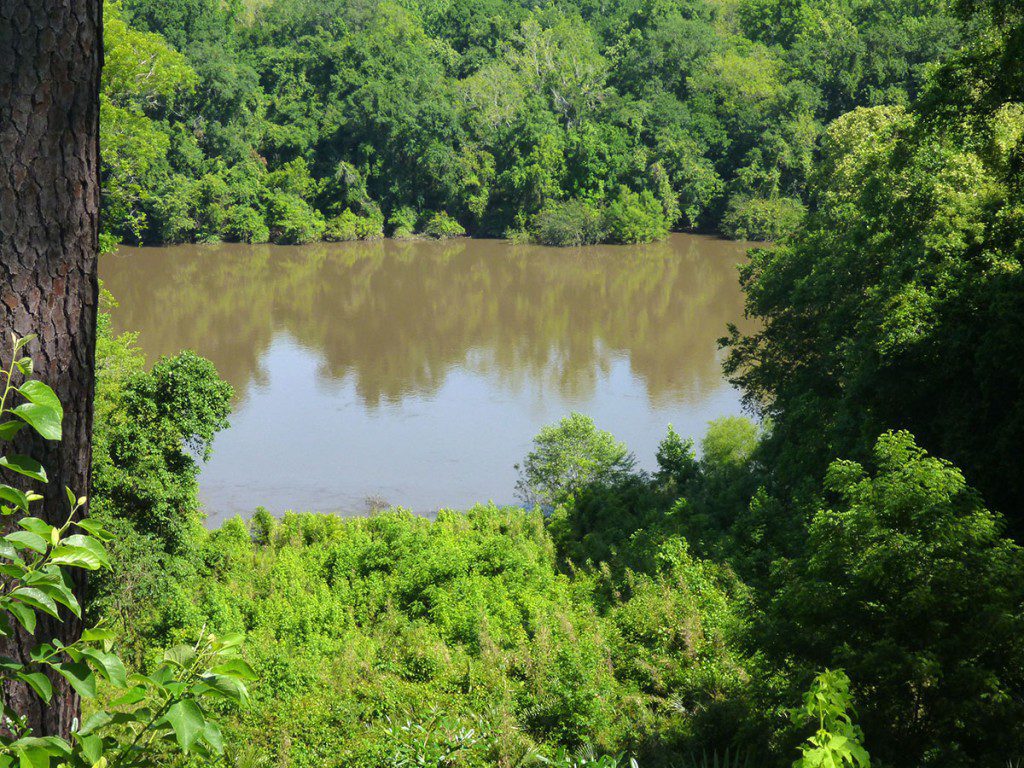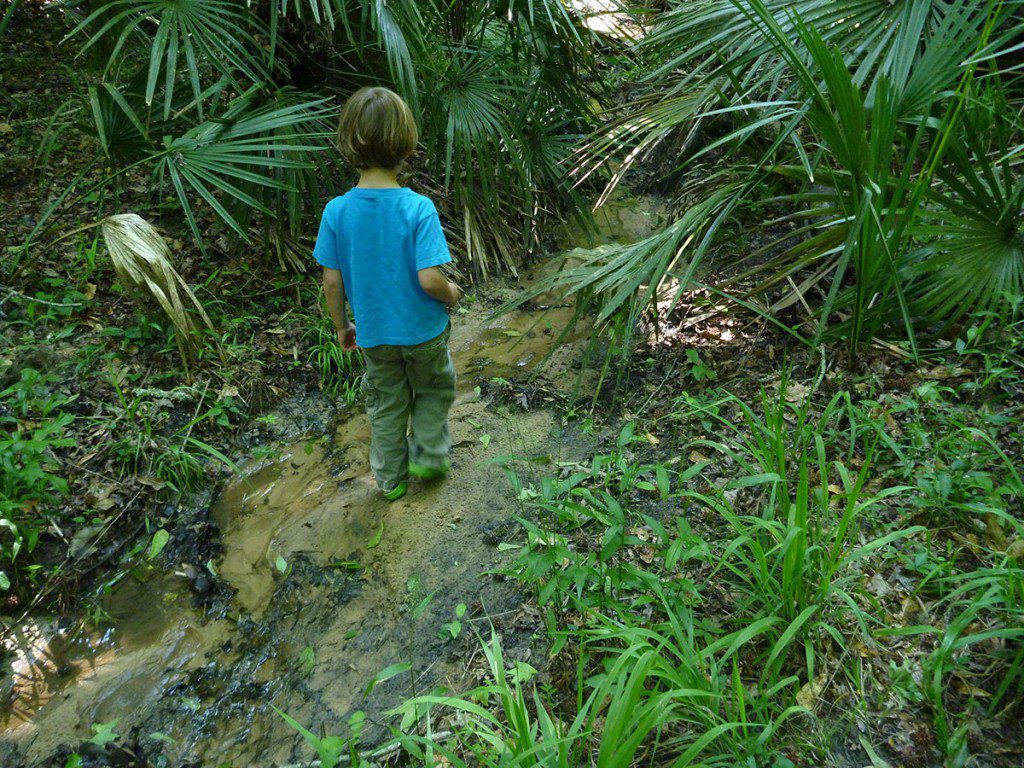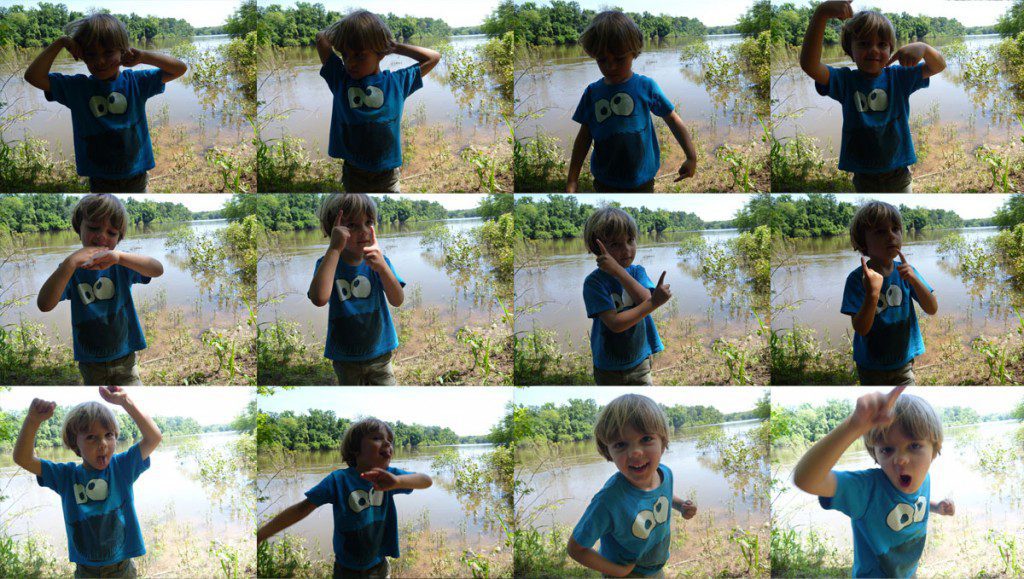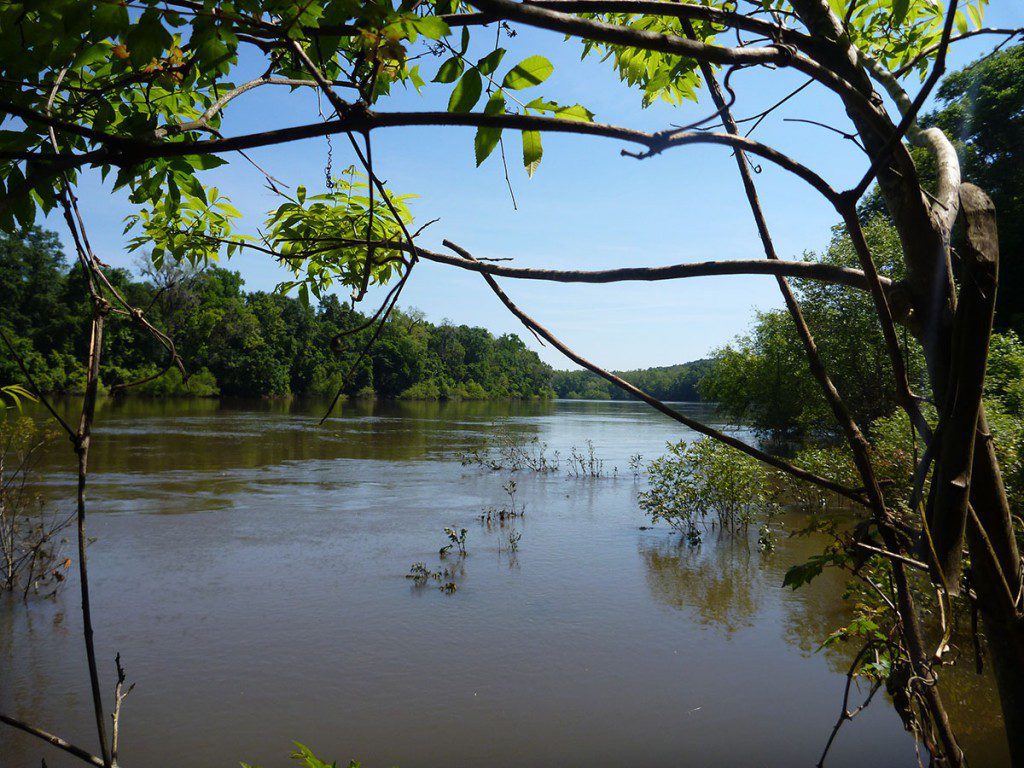Thieving raccoons, high water on the Apalachicola, and learning to follow trail blazes make for a memorable camping trip for a WFSU producer and his son.
Rob Diaz de Villegas WFSU-TV
One Sunday, I was planting seeds with my son Max when I decided that we needed to go camping that next weekend. We were at the tail end of what I guess is Festival Season in Tallahassee, and it had been fun. We saw a lot of cool things, got a little wet as nature tested the “rain or shine” claims on festival posters. But it was an awful lot of spring weekends in town. It was time to get out.
It’s important for both mommies, daddies and children to be out in nature, but for different reasons. The mommy/ daddy reason is, often, that we need a break from the day-to-day of work to get out in nature and unwind. But, when you bring a child, you have to balance that with your parenting duties. What does that balance look like? Let’s start with this verdant forest scene taken in Torreya State Park:
Those trees you glimpse behind Max’s bouncing head- that symbolizes the amount of time you spend enjoying nature on your own terms. Max’s bouncing head- that represents the amount of time you spend parenting. But that’s okay. You can still have fun. If you make it an awesome experience for them, you will enjoy it in ways that you might never have expected. In the following account, you’ll see that while it’s a bit of work, a four-year-old can be a great adventure buddy.
A Beach Stop at Bald Point State Park
In my previous posts about taking kids into nature, my counsel has been to keep excursions simple. I’m ignoring this today, as I also have a need for salt water and coastal breeze. After a recent shoot there, I’ve decided to go to Bald Point. This is a good, wild beach at the mouth of the Ochlockonee River.
My initial thought was to camp nearby at Ochlockonee River State Park, but my sudden inspiration to go camping plus a couple days of procrastination left me looking at a completely booked campground. I next tried two other state parks where I could camp even closer to the beach- St. George Island and St. Joseph Peninsula- but I was out of luck there as well. I had always wanted to camp at Torreya, even if was ninety miles from the coast. Luckily I snagged the last available campsite. Our local state parks are in demand.
After Max’s t-ball game and a picnic lunch with my wife and younger son, Xavi, we head out. We pass through Panacea and its Blue Crab Festival traffic (another festival!). By the time we get to the beach, it’s already 2:30.
The narrow sliver of high tide beach is crowded but quiet; many of the visitors are lined up fishing by submerged oyster reefs along the river mouth. I had wanted to show Max the reefs, but I can see that he’s not concerned about exploring coastal ecosystems today.
Instead, he runs onto the sand and starts throwing it up in the air. He’s loud. He pours sand over his head. Behind us, dunes are roped off to protect nesting plovers. He knows not to run at birds on the beach, but I wonder if he’s agitating some of the little sandpipers by the water’s edge. After a while he settles down, and I relax as well. I’ve never been on a beach so full of people and yet so silent. It makes me a little self conscious. I have to remind myself why we call it an “outdoor voice.” I remind myself that I’ve brought him outside to do something with all of his four-year-old energy. He does, and we settle down to dig moats and inspect shells inhabited by hermit crabs- banded tulips, moon snails, murex, and crown conch.
We spend a couple of hours here. He’s really having fun so I have to start preparing him for our departure about thirty minutes before I want to leave. It takes about 10-15 minutes to get him on board with the idea of leaving. It takes another 10-15 to get him out of the water (it took about 30 minutes to get him to go in the water). We get out just after 4:30, which, after Google’s projected hour-and-a-half of driving, puts us in Torreya State Park well before sunset, when the gates close. Max sleeps soundly the whole way there.
Watch Out for the Copperheads
Pulling into the campsite at 6:15 pm, I see a sign that says to check in by 5:00. The reservation I printed from Reserve America (all State Park camping is booked here) only says to arrive before gates close at sunset. There is someone in the office, however, and he’s friendly despite my late arrival.
“You’ll want to keep an eye out for copperheads” he says, holding up a photo. “We had two bitings last week. A man got bit in the yurt and spent the night in the hospital. Then a dog was bitten and they had to spend $750 at the vet for it.” (A yurt is a kind of tent used by central Asian nomads, of which there is one on the campgrounds)
We get our parking pass and head back to set up our tent. Max really wants to help, so we take it slow. Having a four-year-old help usually means you’re just getting them involved, and you may have to work slowly and redo things more than you would normally. But I need to build on his desire to help, so I gladly accept it.
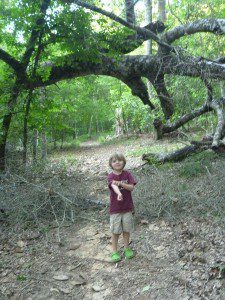 Due to my strange ideas about scheduling, we’re here a little late but I know that the sun will set after 8:00. We explore the trail that heads from the campgrounds. I point out the blue trail blazes on the trees. “That’s how we know we’re on the path.” Looking at the map, I see that Torreya State Park has two loop trails marked in orange; we’re on one of the blue blazed trails that connect places in the park to these main trails.
Due to my strange ideas about scheduling, we’re here a little late but I know that the sun will set after 8:00. We explore the trail that heads from the campgrounds. I point out the blue trail blazes on the trees. “That’s how we know we’re on the path.” Looking at the map, I see that Torreya State Park has two loop trails marked in orange; we’re on one of the blue blazed trails that connect places in the park to these main trails.
Characteristically, Max first says that he’s scared of the trail; but by the time I’m ready to head back, he doesn’t want to leave. He keeps meandering off of the trail and I keep reminding him about snakes. I’m on a constant lookout. To Max, now, the trail is a train track on the Island of Sodor, and we have to dodge Thomas the Tank Engine and his friends. I look at my watch and decide that we need to get back to our campsite. We don’t want to start dinner late.
A Text Message Sent to my Wife at 9:20 pm:
“A raccoon just stole our hot dog buns.”
I am not a woodsman. I am not a master of fire.
There were some nice flames for a while there. It took a little while to cook our hot dogs, maybe because I kept fiddling with the fire. Anyhow, it got a little late.
Also, I can be something of a minimalist. For those moments I had the fire kind of going, it was our light. As it died down, I used my headlamp. Max would loudly note how brightly lit our neighbor’s campsite was. Next to their RV they had hung lanterns and had a nice table set up. The husband had nicely given me the wood I was using (Torreya prohibits you from gathering wood; it is instead provided by the Friends of Torreya State Park).
Meanwhile, I’m hunched over the fire; our only light emanating from my forehead onto our hot dogs.
Then, I hear a rustling over in the darkness by the picnic table. Whipping my head around, I see something furry run off with a bag. The hot dog buns! I chase after the creature, thinking that the pursuit of a large mammal will frighten it into dropping the buns. I stop and look up, and instead of being angry, I wish I had a camera. A raccoon is standing on its hind legs, holding up our hot dog buns. It’s looking right at me. I could chase it all night, but for what? What would I do with a raccoon if I managed to get my hands on it?
When I get back, Max is distraught. “I don’t like hot dogs with no buns.” Eventually he eats them. “Eating hot dogs without buns is my favorite way to eat them.” I love this kid. I stick some marshmallows close into the red glowing spot where the logs meet. I don’t have to worry about burning them.
I read bedtime stories by headlamp. I sleep better than I usually do while camping, thanks to all the extra bedding I packed. Two times I wake up, and I can hear that raccoon and his/ her buddies running around. All the food is in here with us, you little monsters!
When I wake up for good, a little after 7 am, all I hear is birds. A whole forest full of birds. I must be awake before most of the other campers; I don’t hear a single person.
Yesterday was fun, but I had us rushing around. By the time we actually got to just sit at our campsite, it had gotten late and I had to contend with our fire and ill-mannered wildlife. Now begins the best part of the trip.
Breakfast is easy; Clif bars and oranges. We move our chairs to the back of our campsite, which slopes for a couple dozen yards before a network of logs cuts you off from the steeper part of a ravine. We eat. Max scampers down and climbs up on the log behind our site. He says he wants to climb down. I can’t tell if he’s serious.
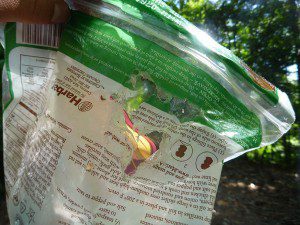 While I’m down here, I see a plastic bag behind one of our neighbor’s sites. I go and get it. I’m glad that I haven’t contributed to polluting this place, even indirectly via raccoon.
While I’m down here, I see a plastic bag behind one of our neighbor’s sites. I go and get it. I’m glad that I haven’t contributed to polluting this place, even indirectly via raccoon.
It’s tough to get Max to break camp. He thinks we should stay a few days.
“Max,” I say, “Do you want to see the Apalachicola River?”
“Yes I do!”
“Then let’s go!”
It still takes a while, but we have a purpose, and that gets us moving.
A Trek to the Apalachicola River
In previous posts about my outdoor excursions with Max, his love of the Apalachicola has been prominent. I’ve spent some time working on river and bay segments, and the photos and videos I’ve shown him have given him the idea that this is a place where adventure happens. I’ve worked to nurture this feeling within him. It has led to a love of kayaking and camping; and I want to fill these early years with positive outdoor experiences that stay with him.
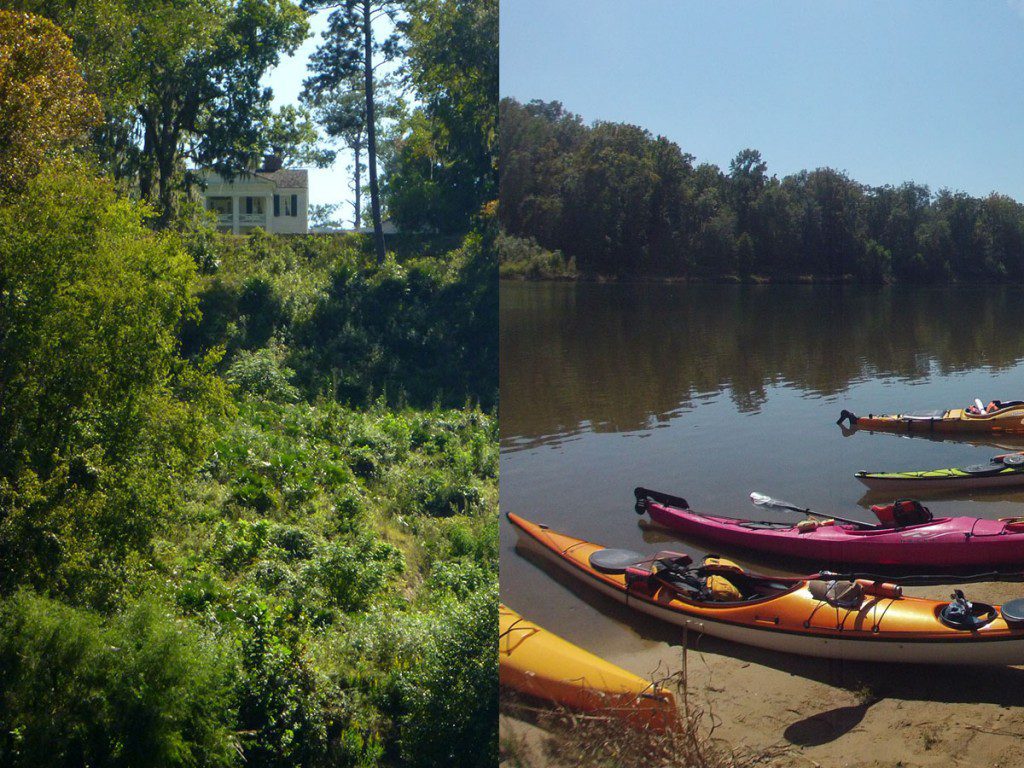
After bushwhacking through the Aspalaga Unit of Torreya State Park, 2012’s RiverTrekkers ate lunch on this sandbar (R) opposite the Gregory House (L).
We start at the Gregory House. Originally built in the 1840s, the Civilian Conservation Corps moved the house from across the river when the park was created in 1935. I’ve only ever seen it from the river. In fact, I remember having lunch on a sand bar across the river, looking up at the house on its perch high atop a bluff. Looking down from that bluff now, I don’t see the sand bar. There’s a reason the Apalachicola Blueway Paddling Guide doesn’t recommend camping on sandbars in the spring wet season; your tent would get awfully wet under all that water.
One of those blue blazed trails leaves from behind the Gregory House. When we get to the main orange blazed trail, there is a sign pointing to the left that indicates the way to the Rock Bluff Primitive Camp sites. What it doesn’t say is that to the right is the Apalachicola River.
Max is funny when it comes to walking and hiking. I’ve often heard “I’m tired of walking. Pick me up.” I sometimes hear this after only a few steps. For such an energetic kid, he can get “tired” after minimal exertion. It’s heavily tied to his motivation and excitement level; in that way he is not unlike his father. Luckily, he wants to see the river.
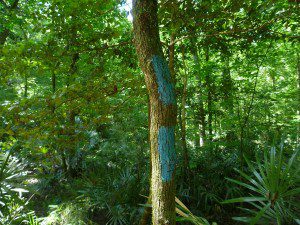 And that’s good, because this is more challenging than any trail I’ve taken him on to date. But he knows how to follow a trail now. “The blue paint on the tree means we’re on the trail.”
And that’s good, because this is more challenging than any trail I’ve taken him on to date. But he knows how to follow a trail now. “The blue paint on the tree means we’re on the trail.”
I’m impressed. “That’s good, son. Now see how this tree has two blazes? That means the trail turns.” The trail zig-zags down the river bluff, often at tight turns. Sometimes we walk into an apparent dead end, and I look back and see the double blaze. We missed a turn. But the trail is well marked, so we keep moving in the right direction.
We’re in a dense forest, and fallen trees cross the path at multiple points. The Friends of Torreya State Park maintain the trail, and while the logs stay in place as nature intended, a section of each is chain-sawed out to keep the trail clear. As we get closer to the river, though, we get to some recently fallen trees that lie intact. One has just the slightest nick from a chainsaw in it, a job to be finished another day by dedicated volunteers. I’m glad that a couple of logs temporarily remain as impediments; Max happily climbs over them. They add to the adventure.
At some point, a little bridge crosses over the smallest of streams. He walks around the bridge to splash in the water. That stream then runs alongside the trail, so that he walks in water as often as not. Soon, the stream drains into a creek, and the creek into the river itself.
I try to get a photo of him by the river, but he won’t stay still. And why should he?
Trees stick out of the water, and fish forage on the higher ground made available to them during the rainy season. Water flows by on its way to tupelo swamps and oyster beds. It’s an El Niño year, I’ve been told, and rain and high water have led to the cancelation of shoots I’ve scheduled on other rivers. But having been on this river during a dry La Niña year, the driest on record, I’m happy to see high water. The Apalachicola grew up with these cycles, but changing climate has made them more extreme, while upstream manipulation of flows further knocks the river off its ancient rhythms. But that’s not what I think about when I’m here with Max. I just want him to see it. If he stops jumping around for a second he just might.
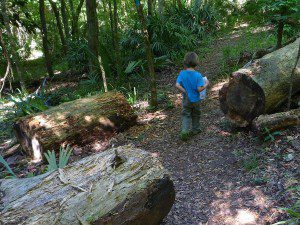 We make the trek back up, which going up hill should be more work. But I’m never asked to pick him up. We eat watermelon on the benches behind the Gregory House, and I’m grateful to have had both the close-up and and the high-up perspective of the Apalachicola River today. After a quick stop at the park’s playground, we head home.
We make the trek back up, which going up hill should be more work. But I’m never asked to pick him up. We eat watermelon on the benches behind the Gregory House, and I’m grateful to have had both the close-up and and the high-up perspective of the Apalachicola River today. After a quick stop at the park’s playground, we head home.
When we get there, Amy meets us in the driveway and quickly diverts us to the back yard. Xavi is napping. Max and I are put to work planting flowers in pots. I take one out and start squeezing the root ball beneath it.
“I want to break up the root ball!” Max says. I’m surprised that he knew to say this, and am pleased with how well he loosens all of the little strands of root.
Amy tells me that with us out of the house last night, Xavi slept through the night. In fact, starting later in the week, he’ll soon start sleeping through almost nightly. This makes me feel a little better about taking him camping. Family trips are on the horizon. I wonder if I’ll ever get the same one-on-one outdoor adventures with Xavi that I’ve had with Max. It only seems fair. But would Max ever let us go camping without him? I have plenty of time to think about this. For now, I’m just happy with how this last trip went. We came back plenty dirty from out trip, and we’re getting dirtier still in the garden. It has been a good weekend.
- As always, remember to pack plenty of water and sunscreen. It is tick season, so check for those and be thorough. The map I picked up at the office implored us to “Leave only footprints and take only pictures.” Familiarize yourself with the rules at any outdoor place you visit. And, as always with children, be patient. You want them to enjoy nature and want to return.

